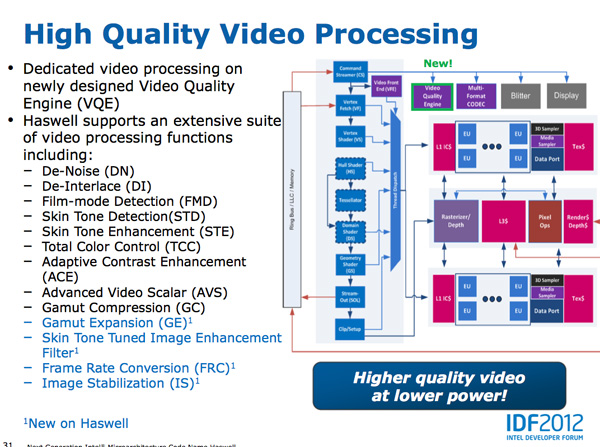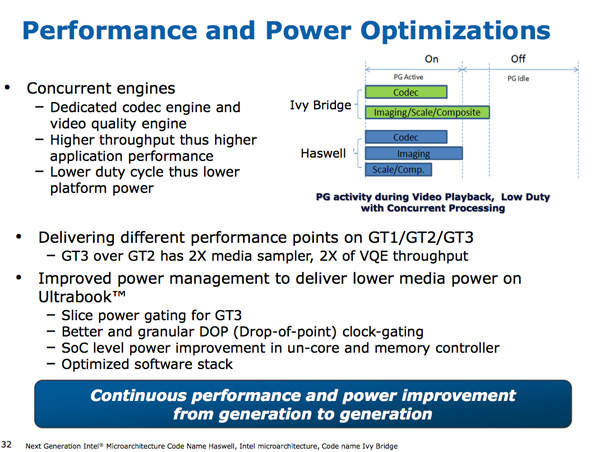Intel's Haswell Architecture Analyzed: Building a New PC and a New Intel
by Anand Lal Shimpi on October 5, 2012 2:45 AM ESTHaswell Media Engine: QuickSync the Third
Although we still have one more generation to go before QuickSync can apparently deliver close to x86 image quality, Haswell doesn't shy away from improving its media engine.
First and foremost is hardware support for the SVC (Scalable Video Coding) codec. The idea behind SVC is to take one high resolution bitstream from which lower quality versions can be derived. There are huge implications for SVC in applications that have varied bandwidth levels and/or decode capabilities.
Haswell also adds a hardware motion JPEG decoder, and MPEG2 hardware encoder.
Ivy Bridge will be getting 4K video playback support later this year, Haswell should obviously ship with it.
Finally there's a greater focus on image quality this generation, although as I mentioned before I'm not sure we'll see official support in a lot of the open source video codecs until Broadwell comes by. With added EUs we'll obviously see QuickSync performance improve, but I don't have data as to how much faster it'll be compared to Ivy Bridge.













245 Comments
View All Comments
tipoo - Sunday, October 7, 2012 - link
I don't think so, doesn't the HD4000 have more bandwidth to work with than AMDs APUs yet offers worse performance? They still had headroom there. I think it's just for TDP, they limit how much power the GPUs can use since the architecture is oriented at mobile.magnimus1 - Friday, October 5, 2012 - link
Would love to hear your take on how Intel's latest and greatest fares against Qualcomm's latest and greatest!cosmotic - Friday, October 5, 2012 - link
Ah, an MPEG2 encoder. Just in time!jamyryals - Friday, October 5, 2012 - link
This made me :)name99 - Friday, October 5, 2012 - link
We laugh but one possibility is that Intel hopes to sell Haswell's inside US broadcast equipment.There isn't much broadcast equipment sold, but the costs are massive, and there's no obvious reason not to replace much of that custom hardware with intel chips.
And much of the existing broadcast hardware (at least the MPEG2-encoding part) is obviously garbage --- the artifacts I see on broadcast TV are bad even for the prime-time networks, and are truly awful for the budget independent operators.
Much like they have written a cell-tower stack to run on i7's to replace the similarly grossly over-priced custom hardware that lives in cell towers, and are currently deploying in China. Anand wrote about this about two weeks ago.
vt1hun - Friday, October 5, 2012 - link
Do you have an idea when Intel will move to DDR4 ? Not with Haswell according to this article.Thank you
tipoo - Friday, October 5, 2012 - link
Haswell EX for servers will support DDR4, but even Broadwell on desktops is only DDR3, we won't see DDR4 in desktops until 2015.jwcalla - Friday, October 5, 2012 - link
We'll probably see DDR4 in the ARM space before we have it on Intel.Maybe this should be AMD's focus of attack: if they can't compete on performance, at least try on chipset features.
Perhaps Intel's biggest concern would be if somebody comes along with a super-efficient x86 emulator for ARM. Going forward, "legacy applications" is going to be an increasingly important selling point to prevent ARM inroads on the low end.
Microsoft keeping their Windows ARM version locked-down is a key to that too, and likely a deference to their relationship with Intel. But Apple is less likely to similarly constrain themselves.
meloz - Saturday, October 6, 2012 - link
>We'll probably see DDR4 in the ARM space before we have it on Intel.>Maybe this should be AMD's focus of attack: if they can't compete on performance, at least try on chipset features.
The problem with DDR4 is likely going to be the price. We all know how the memory industry likes to jack up the prices whenever a new spec comes out. Remember how expensive DDr3 was when it started to replace DDR2?
Some people joke that this transition is the only time they make any money in the RAM business, and considering the low prices of DDR3 you have to wonder.
DDR4 might offer some performance and power advantage on release, but it will likely be more expensive and take time (12-18 months?) to offer a compelling performance / $ advantage over cheap DDR3 variants.
If AMD is trying to position itself as 'value' brand, chaining themselves to DDR4 (before Intel's volume brings down the prices for everyone) could spell their doom.
Kevin G - Friday, October 5, 2012 - link
Intel is set to launch Ivy Bridge EX on a new socket late in 2013 on a new socket. The on-die controller will likely use memory buffering similar to what Nehalem-EX and Westmere-EX use. The buffer chips may initially use DDR3 but this would allow for a trivial migration to DDR4 since the on-die controller doesn't communicate directly with the memory chips.Come to think of it, Intel could migration Nehalem-EX/Westmere-EX to DDR4 with a chipset upgrade. Vendors like HP put the buffer chips and memory slots on a daughter card so only that part would need replacement.